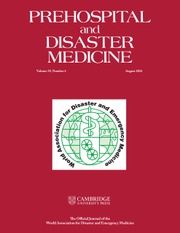Introduction
Carbon monoxide (CO) poisoning is one of the leading environmental emergencies with high mortality and morbidity.Reference Roth, Schreiber, Herkner and Havel 1 It usually occurs as a result of incomplete combustion of organic substances during a fire. Since CO is a colorless and odorless gas, its toxicity is usually noticeable late. The affinity of CO to hemoglobin is around 200-times higher than that of oxygen. In the case of toxicity, a large amount of carboxyhemoglobin (COHb) compound is formed, and there is not enough hemoglobin in the circulation to carry oxygen to the tissues. This is the basic pathophysiological process that causes toxicity.Reference Hoyte, Brent, Burkhart and Dargan 2
The main purpose of treatment in CO poisoning is to provide CO elimination and to correct hypoxemia as soon as possible. Therefore, high-concentration oxygen is the cornerstone of the therapy.Reference Weaver 3 Conventional oxygen therapy is administered with a nasal cannula or a face mask. Although reservoir balloon mask is useful in a normobaric environment, hyperbaric oxygen therapy is the most effective method in CO toxicity. However, special equipment is required for hyperbaric oxygen therapy, and this treatment cannot be performed in many centers.Reference Buckley, Juurlink, Isbister, Bennett and Lavonas 4 Therefore, there is a need for alternative treatment modalities in this area. Non-invasive continuous positive airway pressure (CPAP) ventilation is a method that is frequently used in the treatment of major respiratory emergencies, such as acute pulmonary edema, and is effective in tissue oxygenation.Reference Vital, Ladeira and Atallah 5 Therefore, it is thought that CPAP may also be useful in the treatment of CO poisoning.
Case Report
A 63-year-old man and his 58-year-old wife were brought to the emergency department for being exposed to fireplace smoke in their home on a windy day. Both had complaints of dizziness, headache, and nausea. The man had a history of congestive heart failure, and additionally had shortness of breath; his vital signs were within normal limits, other than hypertension (172/88mmHg). His wife was relatively better and had no significant vital instability. The patients, who were considered to have CO poisoning, were monitored in the emergency department and examined in this respect. In the initial blood gas analysis, COHb values were 26% in the male patient and 24% in the female patient.
A conventional oxygen therapy with a flow rate of 15L/min was started with a reservoir balloon mask for the female patient. Initially, hyperbaric oxygen therapy was considered for her husband, who had shortness of breath. However, the patient would have to be transported to another center to receive this treatment, and his current clinical condition was not suitable for this. Therefore, non-invasive CPAP ventilation was initiated with 100% FiO2 (fraction of inspired oxygen) and 5cmH2O PEEP (Positive End Expiratory Pressure), which is effective for both congestive heart failure and CO poisoning. Blood gas analyzes were repeated every 30 minutes for the first two hours in both patients, and every 60 minutes for the remaining treatment period of the female patient.
It was determined that COHb values decreased below five percent in approximately two hours with CPAP ventilation, and in approximately five hours with the reservoir balloon mask. The change in COHb values over time with both treatments is shown in Figure 1. In follow-up, symptomatic improvement was observed in the patients and routine blood tests, electrocardiograms, and chest radiographs showed no clinically significant additional abnormal results. Both patients were discharged at the end of the day.

Figure 1. COHb Levels Over Time during Oxygen Therapy with Reservoir Balloon Mask and CPAP.
Discussion
Carbon monoxide poisoning is known as the “thousand-faced disease” because it may present with many clinical conditions. In the early period, it may present with relatively mild symptoms such as headache, weakness, nausea, and vomiting, or it may lead to more severe conditions such as chest pain, shortness of breath, syncope, confusion, stroke, seizures, and coma.Reference Weaver 3 After weeks or months, neuropsychiatric disorders such as headache, lethargy, confusion, emotional lability, amnesia, anhedonia, depression, and psychosis can be seen in 40% of cases.Reference Buckley, Juurlink, Isbister, Bennett and Lavonas 4
All patients with CO toxicity are recommended to receive a high-dose of oxygen therapy as soon as possible. These patients should be treated according to emergency medicine standards. Oxygen therapy can be performed by reservoir balloon mask (15L/min O2), non-invasive CPAP ventilation (100% FiO2), or endotracheal intubation according to the clinical status of the patients.Reference Eichhorn, Thudium and Jüttner 6
Non-invasive CPAP ventilation provides tissue oxygenation rapidly and can be applied in many centers, unlike hyperbaric oxygen therapy.Reference Eichhorn, Thudium and Jüttner 6 Non-invasive CPAP ventilation increases FiO2 to 100%, compared with the reservoir balloon mask, and increases the diffusion area and gas exchange of the lung by preventing the alveolar collapse.Reference Vital, Ladeira and Atallah 5 Accordingly, it can be said that CPAP ventilation is more accessible than hyperbaric oxygen therapy and may be more effective than reservoir balloon mask in the treatment of CO poisoning.
Limitations
Although there are insufficient data in the literature about the use of non-invasive CPAP ventilation for CO toxicity, the fact that a single case has been examined in this report is an important limitation. In addition, the long-term effects of CO poisoning in patients treated with this method are not known.
Conclusion
Non-invasive CPAP ventilation, which can rapidly provide tissue oxygenation and CO elimination, may be an alternative method for the treatment of CO poisoning in the emergency department. There is a need for extensive clinical trials that measure the effectiveness of this method and compare it with traditional treatment modalities.
Conflicts of interest/funding
The authors declare that they have no conflict of interest. This study has received no financial support.
Author Contributions
Conception and design: HI and OU; data collection: OU; literature review: HI and OU; writing the paper: HI.



